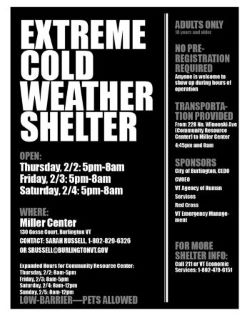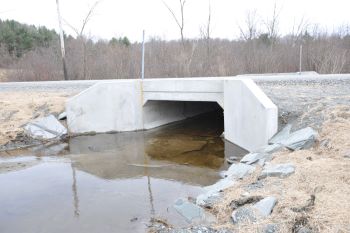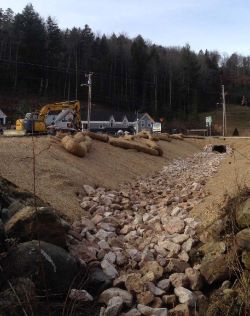
February, 2023
Volume 17 Issue 2
**Best viewed on a computer browser or horizontally if you are on a smart phone**
Warming/Cooling Centers for Extreme Weather Events
February 3rd and 4th were cold, very cold with wind chill values reaching 30-40 degrees below zero in many areas. Morrisville, St. Johnsbury, and Springfield set low temperature records for February 4.
In anticipation of, and response to the cold weather, a number of communities opened warming centers for residents who may have needed to take refuge. Fifteen municipal warming centers were reported to VEM, which allowed us to help publicize them on our website and social media channels.
All Vermont communities are invited to report warming or cooling centers to VEM whenever you open them. Even if you’re just opening the doors to the town offices, fire station, or police station, we can help spread the word and direct those in need to those locations.
If you hear of non-profits or other organizations opening their doors for cooling or warming, you can also report those to us. We will need permission from those running the center before we publish.
To notify us of a facility, simply call 800-347-0488. You will likely be put through to our Watch Officer who can report it to our web and social media teams.
Homeland Security Grant Request for Proposals Open
The State of Vermont, Vermont Department of Public Safety - Homeland Security Unit is pleased to announce the application period for grant funding is now open for the following grant programs:
- State Homeland Security Grant Program
- FY2023 Operation Stonegarden
Where do I look for Information?
For all funding announcements, application materials, instructions and resources, please visit the Homeland Security Unit website. Please familiarize yourself with the requirements of the funding announcements, what must be submitted, and what may be applied for.
When are applications due?
All applications and supporting documentation must be RECEIVED by the Homeland Security Unit by Friday, February 24th, 2023 at 5:00 p.m. EST. Proposals received after this date and time may NOT be eligible for consideration. To facilitate processing, completed grant applications and supporting documentation must be sent via email to DPS.HSUGrants@vermont.gov. Your application and supporting documentation must be received no later than the due date and time listed above. If it arrives at 5:01 p.m. EST, it will be considered late.
For all funding announcements, application materials, instructions and resources, please visit the Homeland Security Unit website.
If you have additional questions about the grant opportunities please contact DPS.HSUGrants@vermont.gov.
Please communicate these funding opportunities to the agencies, organizations, and communities you represent.
The Homeland Security Unit will hold multiple webinars and technical assistance sessions to assist applicants in developing applications. The webinar sessions will be educational session that will provide an overview of the grant program, timelines, and general information on how to apply. The technical assistance sessions will be opportunities for applicants to attend and ask questions, similar to open office hours.
To register for both please visit the Microsoft Forms registration page found here. Registration for sessions will close 24 hours prior to the sessions at which point meeting invites will be distributed to those registered. Please note that registration for the January 18th webinar will close at 9:00 am on January 18th. The dial-in information will be distributed at that time.
|
Homeland Security Grant Program Information Session |
|
|
Webinar Sessions |
Technical Assistance Sessions |
|
Wednesday, January 18th, 2023 2:00-3:00 p.m. |
Thursday, January 19th, 2023 2:00-3:00 p.m. |
|
Wednesday, January 25th, 2023 11:00 a.m.-12:00 p.m. |
Thursday, January 26th, 2023 11:00 a.m. -12:00 p.m. |
|
Wednesday, February 1st, 2023 2:00-3:00 p.m. |
Thursday, February 2nd, 2023 2:00-3:00 p.m. |
|
Wednesday, February 8th, 2023 11:00 a.m. – 12:00 p.m., |
Thursday, February 9th, 2023 11:00 a.m. – 12:00 p.m. |
|
Wednesday, February 15th, 2023 2:00 – 3:00 p.m. |
Thursday, February 16th, 2023 2:00 – 3:00 p.m. |
|
|
Wednesday, February 22nd, 2023 11:00 a.m. – 12:00 p.m. |
|
Wednesday, February 22nd, 2023 2:00 – 3:00 p.m. |
|
Local Emergency Management Plans: What They are and How you Submit Them
Each year between town meeting day and May 1st, every city and town in Vermont is required to adopt and submit a Local Emergency Management Plan to Vermont Emergency Management. This plan serves as the city or town’s guidebook to preparing for and responding to emergencies in their community.
Templates are available on the VEM website, but cities and towns are welcome to submit their plan in any format as long as it contains the required information below.
- Completed Municipal Adoption Form: Included with our template, this is where your city or town documents the names and contact information for your top 3 emergency points of contact, the date the plan was adopted, the date NIMS was adopted, and certify that the plan was adopted and is in compliance with the National Incident Management System.
- List of people who wrote/maintain the LEMP
- Information about the local Emergency Operations Center, including who has the authority to activate the local Emergency Operations Center, Emergency Operations Center staff positions & duties, potential Emergency Operations Center staff members, and facility information for potential EOC locations
- Information about resources, including Emergency purchasing agents/spending limits (if any), list of municipal contracts that can be used during an emergency (if any), list of other local resources that could be used during an emergency (if any), and National Incident Management System (NIMS) Typed Resource List
- Information about Public Information & Warning, including VT-Alert Contact Information, local website/social media information (if any), list of local media outlets (if any), public notice sites for non-phone/internet information, and Vermont 2-1-1 contact information
- Information about vulnerable populations, including a list of organizations/facilities that serve local vulnerable populations, and your identification and monitoring process for the Emergency Operations Center to communicate with vulnerable populations
- Information about shelters, including spontaneous and regional shelter information, and opening and service information for local shelters (if any). This includes identifying if the shelter is a warming center, a cooling center, an overnight shelter, or all 3.
- Contact information for Emergency Management personnel, response organizations, municipal officials, public works, and other municipality contacts.
If you aren’t sure if you have a currently plan on file, please visit the Flood Ready Vermont website and search by your municipality.
Once a city or town has finalized and adopted the plan, it must be submitted to Vermont Emergency Management. Cities and towns may continue to email their plan to their Regional Planning Commission Emergency Management staff member, who will review the plan and, if it is meeting the requirements, email it to Vermont Emergency Management. However, as of January 2023, cities and towns can also submit their plan through WebEOC, the state’s Disaster Management Software.
If the city or town chooses to submit their plan through WebEOC, it will allow the city or town to:
- See where the plan is in the process of being reviewed and approved by the Regional Planning Commission and Vermont Emergency Management.
- Store the plan in the same location throughout the year, which is also the same location where cities and towns can track requests during a disaster.
- Make modifications to contact information throughout the year directly in the plan. If changes are made to the WebEOC plan, it will automatically update the contact information with the Regional Planning Commission and Vermont Emergency Management.
- Receive a notification if all required elements aren’t complete, allowing corrections to be made in advance of submitting. This reduces delays in processing.
- Toggles allow cities and towns to add more information, including additional shelters and Emergency Operations Centers, without worrying about changes in formatting.
If a city or town is interested in submitting the 2023 Local Emergency Management Plan through WebEOC, an individual in town will need to request a WebEOC account and view the Local Emergency Management Plan Update in WebEOC training video. The city or town’s most current plan can be imported into WebEOC by requesting the assistance from your Vermont Emergency Management Regional Coordinator.
Local Hazard Mitigation Plans: What They are and How you Submit Them
Every five years each city, town, and village in Vermont is required to update and adopt a Local Hazard Mitigation Plan (LHMP) to be eligible for certain types of funding for disaster recovery and hazard mitigation. This plan serves as the municipality’s guidebook to reducing or avoiding the impact of and easing the recovery from hazard events in their community. 
There currently is no template for LHMPs provided by VEM, but there are hazard mitigation planning resources available on the VEM website. Experienced planning consultants including Regional Planning Commissions and private consultants are hired by municipalities to create or update LHMPs. Many have their own plan templates that they use to meet requirements. Some municipalities with existing necessary staff capacity will take on LHMP updates on their own.
Municipalities have the option to develop multijurisdictional plans with neighboring communities. Each plan must follow the FEMA policy guidance to meet the federally mandated requirements of LHMPs.
Updated requirements are effective in 2023. Please refer to the policy guidance and plan review tool for details, but general requirements are:
- Document the planning process including:
- Opportunities for neighboring communities, relevant local and regional agencies, and other stakeholders to be involved.
- The incorporation of existing plans, studies, reports, and technical information.
- Include the type, location, and extent of all natural hazards that can affect the jurisdiction with previous occurrences of the hazard events and the probability of future hazard events.
- Summarize the jurisdiction’s vulnerability and the impacts on the community from the identified hazards including NFIP-insured structures that have been repetitively damaged by floods.
- Summarize existing authorities, policies, programs, and resources available to support the mitigation strategy and the ability to expand on or improve these existing policies and programs.
- Include existing building codes and land use and development regulations.
- Document participation in the NFIP and continued compliance with NFIP requirements.
- Provide goals to reduce/avoid long-term vulnerabilities to the identified hazards.
- Identify mitigation projects being considered to reduce the effects of hazards.
- Lay out a mitigation action plan with:
- Criteria used for prioritizing actions
- Who is responsible for implementing/administrating the mitigation actions,
- Potential funding sources
- Expected time frame.
- Detail how public participation will be continued in the plan maintenance process.
- Describe the method, who is responsible, and schedule for keeping the plan current.
- How the progress/status of the mitigation actions identified within the Mitigation Strategy will be tracked.
- How the plan will be evaluated for effectiveness with the criteria that will be used to evaluate the plan.
- How the plan will be updated before it expires 5 years after approval.
- Describe how the mitigation plan will be integrated into other plans or planning mechanisms.
- Optional: Include plans, stakeholder coordination, data, risk assessment, and mitigation actions related to High Hazard Potential Dams (HHPDs)
 89% of municipalities have at one time had a plan that they adopted, but as of January 2023, 64% have plans that are up to date. Communities without up-to-date plans are not eligible for hazard mitigation grants and a higher percentage of state assistance for projects after declared disasters. More information on these funding mechanisms is linked above. Plans expire 5 years after the last adoption and approval, and the date will be unique to each plan. If you aren’t sure if you have a current plan, please visit the Flood Ready Vermont website and search by your municipality.
89% of municipalities have at one time had a plan that they adopted, but as of January 2023, 64% have plans that are up to date. Communities without up-to-date plans are not eligible for hazard mitigation grants and a higher percentage of state assistance for projects after declared disasters. More information on these funding mechanisms is linked above. Plans expire 5 years after the last adoption and approval, and the date will be unique to each plan. If you aren’t sure if you have a current plan, please visit the Flood Ready Vermont website and search by your municipality.
Once a community has finalized the plan, it must be submitted to Vermont Emergency Management for review prior to adoption. The town, village, city, or planning consultant hired by the municipality will email their plan to the State Hazard Mitigation Planner, who will review the plan and, if it is meeting the requirements, issue an Approval Pending Adoption. The plan can then be returned to VEM who will issue FEMA-approval and email the plan to the Federal Emergency Management Agency.
Please contact Caroline Paske, State Hazard Mitigation Planner, if you have questions on Local Hazard Mitigation Plans or if your municipality is interested in applying for a grant to fund the development or update of a plan.
Training
February 2023
SEOC Orientation
The purpose of this training is to provide an overview of the State Emergency Operation Center. This course is ONLY available to those who are on the SEOC Roster
LOCATION: DPS Headquarters, Waterbury
DATE/TIME: February 14, 2023, 1:00 p.m. – 3:30 p.m.
PREQUSITE: IS-100 and WebEOC State User Training
REGISTRATION: https://vermont.csod.com/ui/lms-learning-details/app/event/04f1ce01-32df-4658-89d6-eda38e586ef0
Vermont Local Emergency Management Director Course
This course will familiarize local Emergency Management Directors (EMD) and Coordinators (EMC) with major roles, responsibilities, and “how to do it” guidance, across all four phases of Emergency Management.
LOCATION: Virtual
DATE/TIME: February 21-22, 2023, 2:30 - 5:00 p.m. each day
PREREQUISITE: None
REGISTRATION: https://vermont.csod.com/ui/lms-learning-details/app/event/e35883cd-148f-415c-a554-4107b7533679
NOTE: Must attend both sessions to receive credit
G0191- ICS/EOC Interface
This course provides an opportunity for participants to begin developing an effective interface between he Incident Command System(ICS) and the Emergency Operations Center (EOC) for their community by applying ICS principles. This course reviews ICS and EOC responsibilities and functions and depends heavily on exercises and groups discussions to identify interface issues and develop solutions.
LOCATION: Rutland Regional Planning Commission, Rutland
DATE/TIME: February 23, 2023, 8:00 a.m. - 4:30 p.m.
PREREQUISITE: IS-100, IS-200 or IS-2200, IS-700 and IS-800
REGISTRATION: https://vermont.csod.com/ui/lms-learning-details/app/event/70143e5e-658a-429a-86d3-51ec164e51e7
AWR- 347 Climate Adaption Planning for Emergency Management
This course will enhance your ability to discuss the impact of weather hazards on critical infrastructure and key resources, and explain how climate change projects will affect those impacts.
LOCATION: Virtual
DATE/TIME: February 28, 2023 – March 1, 2023, 1:00 – 5:00 p.m. each day
PREREQUISITE: None
REGISTRATION: University of Hawaii: https://ndptc.hawaii.edu/training/delivery/3229/
Code: 79028
NOTE: Must attend both sessions to receive credit
March 2023
ICS 300- Intermediate ICS for Expanding Incidents – In Person
Hartford Fire Department- Hartford, VT
March 14-16, 2023, 8:00 a.m. – 4:30 p.m. each day
Prerequisite: ICS-100 and ICS- 200
Registration required via State Learning Management System: https://vermont.csod.com/
ICS-100 Prep- Introduction to Incident Command
VA Medical Center, White River Junction
March 22, 2023, 8:00 a.m. – 4:30 p.m. each day
Registration required via State Learning Management System: https://vermont.csod.com/
A laptop is required for this class
K2020 Debris Management Planning for State, Tribal, Territorial, and Local Officials- Virtual
March 28-30, 2023, 8:30 a.m. – 5:00 p.m. each day
Registration required via NETC online admissions system:
https://training.fema.gov/netc_online_admissions/
AWR- 362 Flooding Hazards: Science and Preparedness- Virtual
March 29 – 30, 2023, 1:00 p.m. – 5:00 p.m. each day
Must attend both sessions to receive credit
Registration required via University of Hawaii: https://ndptc.hawaii.edu/training/delivery/3230/
Code: 54271
April 2023
L0146 Homeland Security Exercise & Evaluation Program (HSEEP) - In Person
St Michael’s College
April 1-2, 2023, 8:00 a.m. - 4:30 p.m. each day
Prerequisite: IS-120
Must attend all sessions to receive credit.
Registration required via the State Learning Management System: https://vermont.csod.com/
ICS 200 Prep- ICS for Single Resources and Initial Action Incidents – In Person
VA Medical Center, White River Junction
April 19-20, 2023, 8:00 a.m. – 4:30 p.m. each day
Prerequisite: IS-100
Registration required via State Learning Management System: https://vermont.csod.com/
A laptop is required for this class
AWR- 136 Essentials of Community Cybersecurity- In Person
DPS – Headquarters- Waterbury
April 25, 2023, 8:00 a.m. – 12:00 p.m.
Registration required via the State Learning Management System: https://vermont.csod.com/
MGT 384 Community Preparedness for Cyber Incidents- In Person
DPS – Headquarters- Waterbury
April 25, 2023, 1:00 p.m. – 5:00 p.m. & April 26, 2023, 8:00 a.m. – 5:00 p.m.
Registration required via the State Learning Management System: https://vermont.csod.com/
May 2023
ICS 400- Advanced ICS for Command and General Staff – In Person
Chittenden County Regional Planning Commission- Winooski
May 16-17, 2023, 8:00 a.m. – 4:30 p.m. each day
Prerequisite: ICS-300
Registration required via State Learning Management System: https://vermont.csod.com/
June 2023
PER- 344 Social Media Tools and Techniques - Virtual
June 6, 2023- June 7, 2023, 1:00 p.m. – 5:00 p.m. each day
Must attend both sessions to receive credit
Registration required via University of Hawaii: https://ndptc.hawaii.edu/training/delivery/3265/
Code 03216
PER- 343 Social Media Engagement Strategies- Virtual
June 13, 2023- June 14, 2023, 1:00 p.m. – 5:00 p.m. each day
Must attend both sessions to receive credit
Registration required via University of Hawaii: https://ndptc.hawaii.edu/training/delivery/3266/
Code 81439

